25 Real-Life Robots That Already Exist
Updated: Sep. 22, 2023
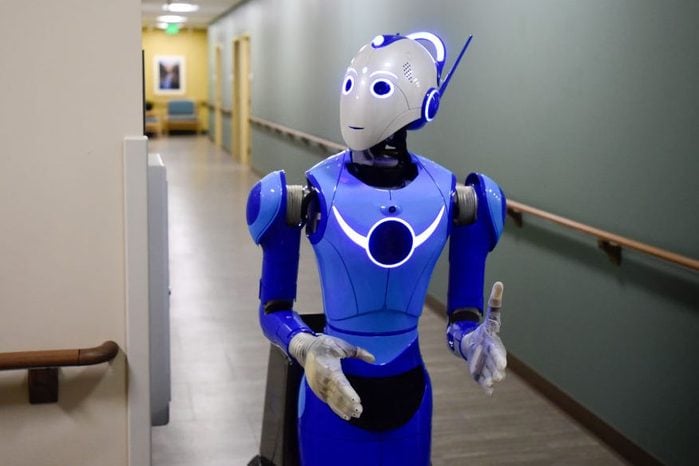
Dozens of real robots exist today—and you might stumble on some of them in your everyday life. Check out the amazing, futuristic robots that are already changing the world.
Picture a robot. What comes to mind? Perhaps something like what you’ve seen in Star Wars or The Jetsons: a machine that can move, speak and perform tasks all by itself. Or maybe your imagination jumps to humanoid robots à la The Terminator. But you might be surprised by the wide range of real robots that exists today, from Roomba vacuums to virtual butlers to self-driving cars.
Most people think that the goal for roboticists is to create robots with human-level artificial intelligence, says Robin Murphy, PhD, a professor of computer science and engineering at Texas A&M University and director of the Center for Robot-Assisted Search and Rescue. “Instead, the goal is to build devices that are useful,” she says. “And useful generally means that they can do something we can’t do, do as well or would be at risk doing”—such as driving, caring for the sick and elderly, or carrying military supplies.
We got the download from robotics experts on the types of real robots that are out there, who makes them and where you might spot one in real life. Once you check out these futuristic robots for yourself, find out how other groundbreaking new tech, like the metaverse and the virtual real estate booming there, is changing the world too.
Types of robots
There are several different categories of real-life robots, according to experts who group these machines based on their abilities and the tasks they need to perform. Here are the most common robot types, what they do and where you might spot them.
Autonomous mobile robots
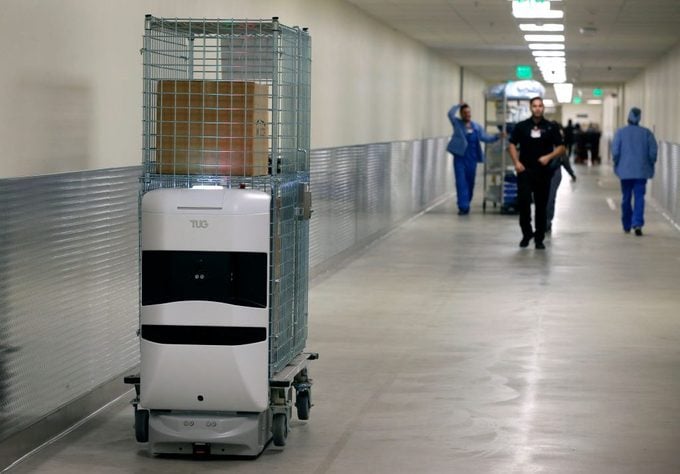
An autonomous mobile robot—AMR for short—is “basically a robot that can drive itself around,” says Chris Atkeson, PhD, a professor at Carnegie Mellon University’s Robotics Institute. Using sensors and cameras, these machines detect their surroundings and then process, analyze and react with built-in computer software. Some examples of common AMRs include self-driving cars and robot vacuums.
Automated guided vehicles
Unlike AMRs, which can move around without any assistance, automated guided vehicles (AGVs) need a physical guide, such as a track or markers to follow, as they drive. This means they are more limited and less autonomous than AMRs, Atkeson says. AGVs are most often found in warehouses and on factory floors, where they can transport items in a controlled environment.
Articulated robots
If you’ve ever watched a robotic arm apply car parts in an assembly line or weld items in a factory, you’ve witnessed an articulated robot in action. Articulated robots have between two and ten joints that allow them to move like human arms, which makes them well-suited for manufacturing and assembly work in factories. Lately, researchers have also been experimenting with using articulated robots in household settings, where they can do chores like put away dishes or serve drinks.
Co-bots
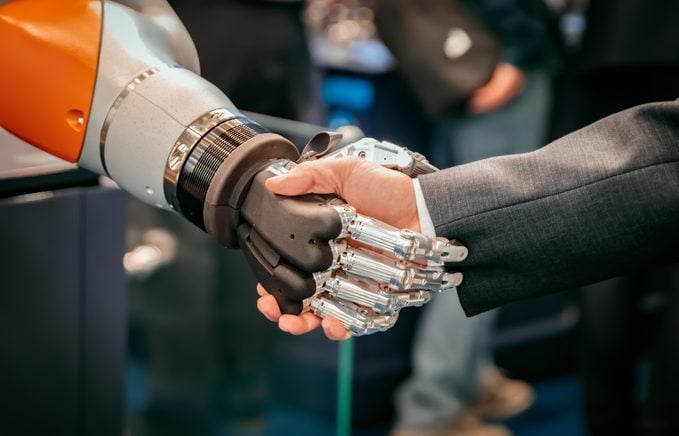
As more and more robots appear on the job, workers are understandably worried about whether automation will make humans irrelevant. But don’t worry: Robots won’t take away your job. Instead, they’ll likely be your future co-workers as the future of AI looks bright.
The name “co-bots” is an apt one for these machines, which are “designed to work with humans” like co-workers, Murphy says. In the past, many real robots used in manufacturing were separated from human workers for safety reasons. But now, co-bots make it possible for people and machines to move around and work in the same environment.
Many co-bots take the shape of a machine or animal, according to Atkeson. They often handle hazardous materials in laboratory or construction settings, and they can carry heavy loads for soldiers in war zones.
Humanoids
Humanoid robots “look somewhat like a person,” Murphy says. They have a human-like body shape—including a head, torso, legs, hands and feet—and share characteristics with humans, like walking upright and speaking.
Humanoids serve two purposes: They can provide social services and use human tools, according to Murphy. The first comes in handy when we need entertainment, friendship or care. The second can be useful for fixing broken items or exploring areas that are unsafe or inaccessible to humans.
Hybrids
By combining two or more of the types of robots listed above, you get what’s called a hybrid robot. Hybrids have multiple capabilities—think wheels and an extended arm—allowing them to perform more complex tasks or functions, such as sorting, handling and moving packages inside of a warehouse or factory.
Robots in real life
However futuristic they sound, robots have been and will continue to be part of our lives. Some were created decades ago, while others are on the cutting edge. (Amazon even makes an Astro home robot that goes above and beyond Alexa.) By 2050, robots will be a presence in countless areas of our lives, and interacting with them will feel like second nature.
The following are the real robots that revolutionized the past and promise to shape our future.
Shakey
Believe it or not, real robots have been around for more than 50 years. SRI, a nonprofit research institute, built the world’s first mobile robot between 1966 and 1972. Its creators named it Shakey, and it certainly shook up the world of robotics.
With sensors and cameras, Shakey could perceive its surroundings, make plans and perform simple tasks, like rearranging objects—making it one of the earliest forms of artificial intelligence. Though large and clunky by today’s standards, it was revolutionary for the time and gave birth to future robotics technology. Though it’s since been retired, you can “visit” Shakey at the Computer History Museum in Seattle.
Pepper
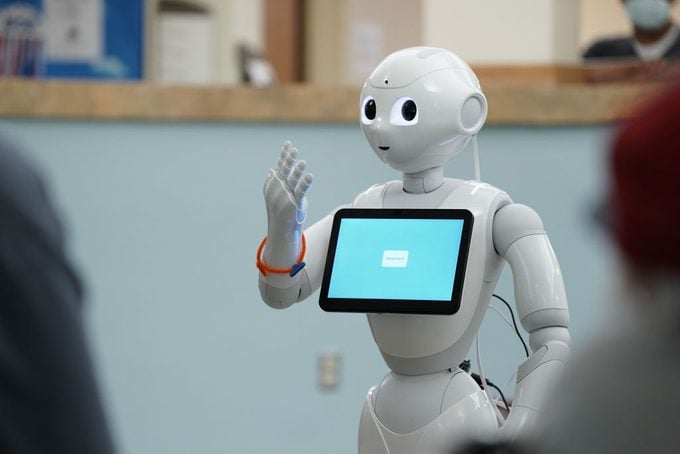
Pepper is one of the world’s first human-like robots that can recognize faces and emotions. Created by the Japanese company Softbank, the Pepper robots sold out in minutes when they were first released in 2014. They were designed to interact with humans, answering customer questions, recommending products to retail shoppers, helping people fill out bank forms and assisting with hands-on learning in classrooms.
The cute, friendly humanoid robot never quite lived up to its promise, and the company paused production in 2021. But you can still find them in use today at banks in Japan, Taiwan and the United Arab Emirates, where they provide services like greeting customers.
Atlas
Atlas, a humanoid robot built by Boston Dynamics, is the most advanced robot that exists today, according to Murphy. Its state-of-the-art hardware (including 28 joints!) allows it to run, leap and flip like an athlete. Oh, and it can dance.
Right now, researchers are teaching Atlas to navigate complex obstacle courses to test the limits of its physicality. But don’t expect to bring home your own Atlas anytime soon. The company calls the robot a research and development program “pushing the bounds of robotics forward.” In other words, this one isn’t available for purchase.
Spot
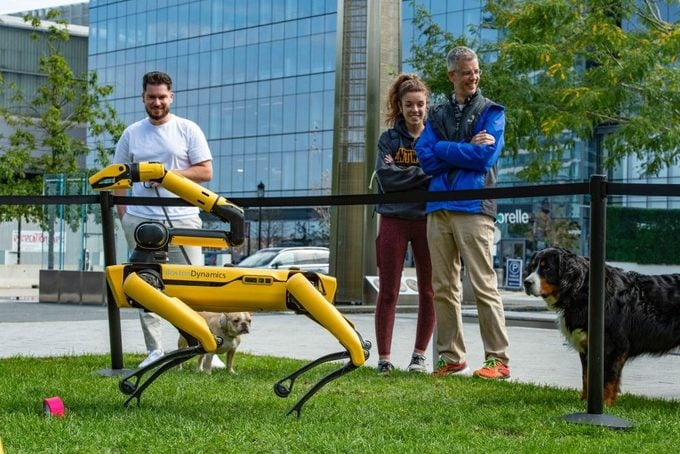
Another robot created by Boston Dynamics, Spot is a 70-pound dog-shaped co-bot that can walk, trot and climb over a variety of terrains, including loose gravel, grass, curbs and stairs. It’s used by manufacturing, construction and utilities companies, like BP and Woodside, that need robots that can handle dangerous materials, detect hazardous leaks and navigate locations that are unsafe for humans.
Of course, this model robot is probably best known for its other job: the one with the cops. In 2020, the New York City police department began using the canine-like robot for select cases. Despite a cute nickname (Digidog), the public wasn’t thrilled. Some maintained that the expense was too great, while others found the robodog—and its cameras that come a little too close to surveillance tools—just plain creepy. Not long after it acquired the machine, the NYPD canceled its lease.
But that hasn’t stopped all law enforcement from adopting robotic sidekicks. In preparation for Fourth of July festivities, the Massachusetts State Police bomb squad used the company’s robotic dogs to clear packages.
Domino’s delivery robot
In Japan, you can get sushi delivered by robot. And in Houston, you can get pizza. Fast-food chain Domino’s has partnered with the robotics company Nuro to launch a pilot program that delivers fresh-made pizzas via self-driving AMR robots. All customers have to do is opt in to Nuro’s R2 delivery service, meet the robot outside when it arrives and enter an access pin to unlock the door and get their pizza.
ASIMO
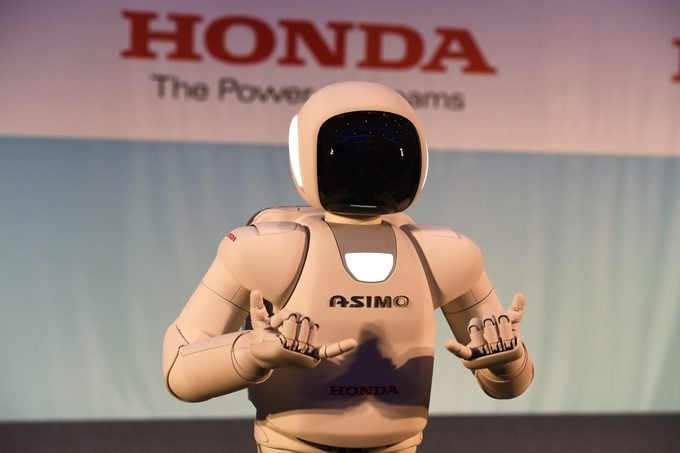
Honda has spent more than a decade building ASIMO, a humanoid robot that the company hopes will someday help us around the house. ASIMO, which stands for Advanced Step in Innovative Mobility, can communicate in American and Japanese sign language, run at speeds of up to 5.6 miles per hour and predict and respond to its surroundings. Though ASIMO is not currently for sale, Honda hopes it will hit stores by 2030.
Nao
At Mitsubishi UFJ, the biggest bank in Japan, a robot will greet you, help you open a bank account and more. Aldebaran Robotics developed Nao in 2006, and SoftBank Robotics (which later acquired Aldebaran) released the sixth edition in 2018. The humanoid robot speaks 20 languages and costs around $8,000. You can see one for yourself at the bank’s flagship location in Tokyo.
Considering Nao’s friendly eyes and build, it should come as no surprise that SoftBank Robotics also sees a place for the robot in the classroom (as teaching aids) and hospital (as health assistants, for instance).
Roomba
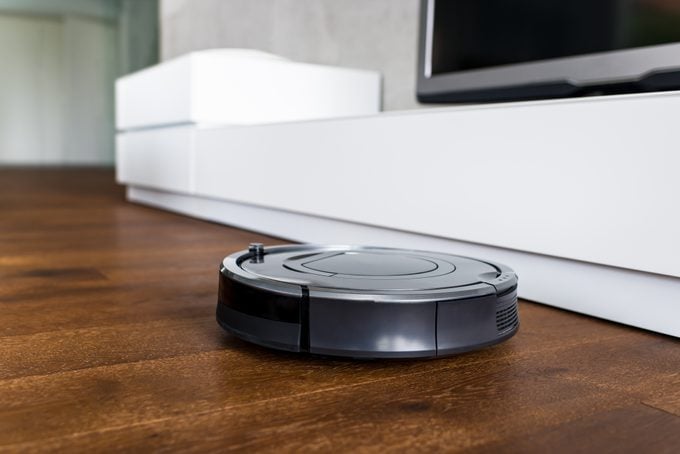
One of the world’s most famous AMR robots might be sitting in your house right now. Roomba, built by iRobot in 2002, is a robotic vacuum cleaner that navigates your home using sensors. The first of their kind, Roombas are now in more than 40 million homes worldwide.
Walker X
With Walker X, your home could become a whole lot smarter. This humanoid robot acts like a butler, helping around the house with day-to-day tasks like hanging up coats, serving drinks, wiping down surfaces, entertaining children and more. UBTECH Robotics demonstrated Walker X’s latest abilities at a conference in 2021: It can traverse all types of terrain (yes, even thick carpet), is self-balancing (so kids won’t tip it over) and can navigate spaces without knocking into furniture (so great-grandma’s fine china is safe).
But don’t get too excited. Walker X is still under development and won’t be in households anytime soon.
Telepresence robot
Ava Robotics has designed a robot that raises the standards of remote work for the future. This AMR, which consists of a high-definition video screen on wheels, allows workers to call into a teleconference to meet with colleagues. Sounds like Zoom, right? Here’s where the two diverge: Because this screen is on wheels, callers can “move around” a remote location as if they were physically there.
Launched in 2018, the bots can also provide security for museums and office buildings, and they allow doctors to assess and diagnose patients from afar.
Ameca
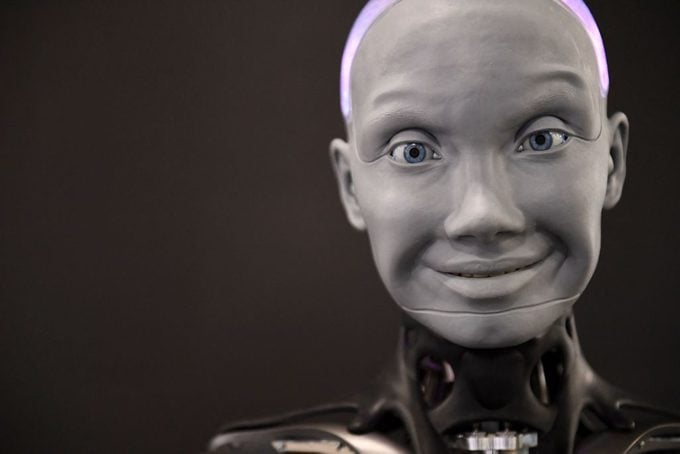
Like many other cool robots, Ameca uses artificial intelligence to analyze and react to its environment. But here’s the catch: Ameca can also express lifelike emotions and facial features like smiling, blinking and even gasping in shock. Despite its metal body and gray, decidedly un-human facial “skin,” Ameca still looks startlingly human—like an early version of Ava from the science fiction movie Ex Machina.
It’s not available for consumer purchase; instead, Ameca was designed as a platform for future robotic tech. In other words, it’s ready for others to further develop it. Manufacturer Engineered Arts put this humanoid up for sale or rental for an undisclosed price back in December 2021.
ADIBOT
Not every robot needs to be human-like or mobile to improve our lives. ADIBOT-S by UBTECH Robotics is a stationary bot that uses 360-degree UV-C light to disinfect surfaces. Developed in response to the COVID-19 pandemic, ADIBOT-S has been used in medical centers, hospitals, hotels, schools, government offices, fitness centers and businesses across the country. The company also makes a roaming AGV disinfecting robot (the ADIBOT-A) that users can program to follow a floor plan.
Waymo
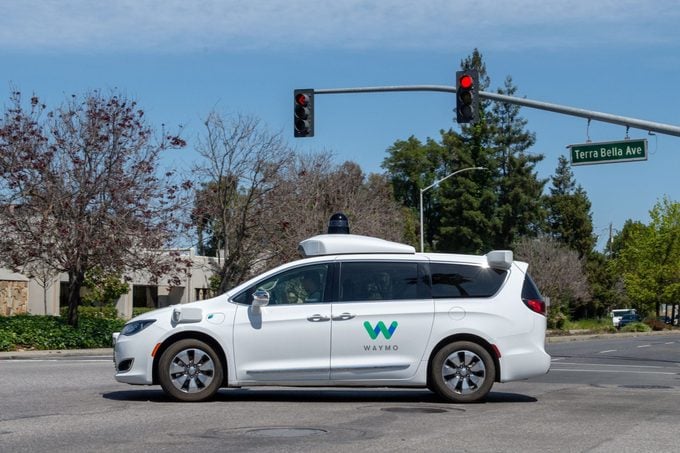
What began as Google’s self-driving car project in 2009 is now a full-fledged company aimed at creating safe driverless cars and trucks. The new company, Waymo, and parent company Alphabet launched their first autonomous car in Austin, Texas, in 2015. The car (an AMR) was equipped with custom sensors, computers, steering and braking; had no steering wheel or pedals; and was “driven” by a legally blind man named Steve Mahan.
Three years later, the company launched the first autonomous ride-hailing service in Phoenix. (Waymo is now testing the service in San Francisco.) And in 2020, it began testing a trucking and delivery program in New Mexico and Texas.
Robear
The research team at the Riken-TRI Collaboration Center for Human-Interactive Robot Research in Japan has created three robot bears so far, and the 2015 Robear is by far the most advanced. This high-tech teddy was designed as a nurse-like aid to help elderly patients. It can lift them, help them stand up and move them from beds to wheelchairs. It’s currently available on an experimental basis in Japan.
SNAG
In 2021, scientists at Stanford University designed a bot that can land on narrow surfaces like branches and carry objects—just like a bird. It’s called SNAG (the stereotyped nature-inspired aerial grasper), and while it may not look exactly like one of our feathered friends, it has some similarities: namely two legs, some wicked claws for grasping and the ability to balance when landing on branches.
The hope is that this technology can be used in future drones and other robots, helping them land anywhere from war zones to neighborhoods.
Sofia
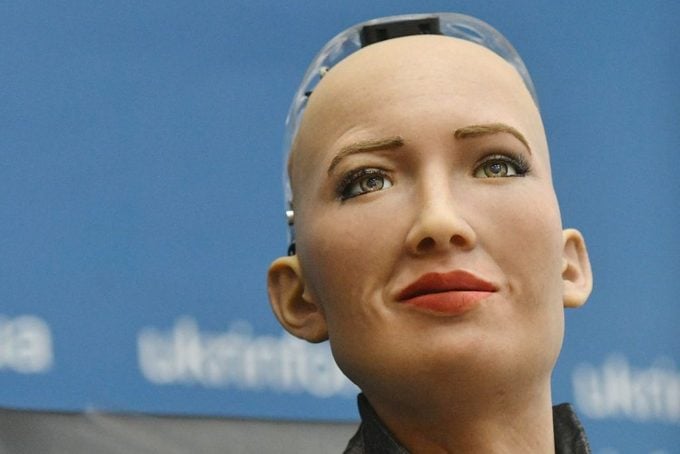
With human features, peachy skin on her face and neck, and makeup that adds to the realism, Hanson Robotics’s Sofia is probably the most futuristic-looking robot around. A good basis for the future of human robots, this humanoid model can hold a conversation, answer questions and even learn and absorb information with artificial intelligence.
Since making her first public appearance in 2016, she’s become one of the most famous robots, appearing on the Tonight Show with Jimmy Fallon and in several magazines. She is now a citizen of Saudi Arabia and an Innovation Ambassador for the United Nations. Oh, and she likes to joke about dominating the human race. At least we hope it’s a joke. Otherwise, it sounds like the start of a sci-fi book we don’t want to live through.
Bot Handy
In the future, when you need a hand around the house, you can look to Samsung’s Bot Handy. The robot uses artificial intelligence, cameras and an articulated robotic arm to pick up laundry, put away dishes, set the table and even pour and serve drinks.
There’s no release date for these robots yet, but they generated plenty of buzz in 2021 when Samsung unveiled them at CES, the consumer electronics show.
RoBoHon
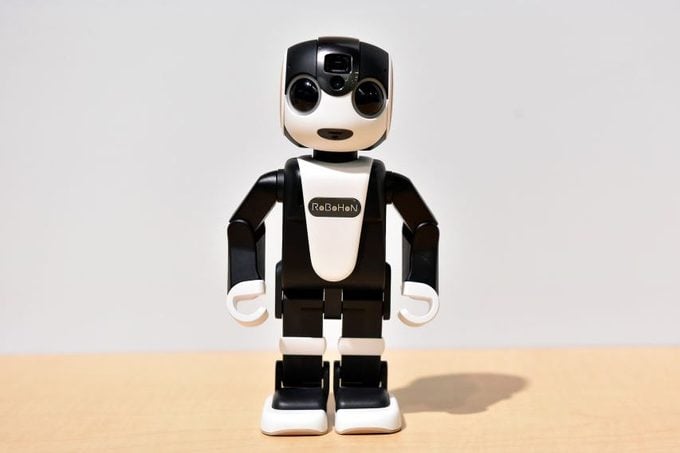
Think your smartphone is a marvel of technology because you can use it to make calls, send emails and even buy cryptocurrency? Imagine a phone with many of the bells and whistles of a smartphone and the ability to move and talk like a human. That’s RoBoHon.
This small robot can make phone calls, send emails, learn about you as you use it, project images onto any surface and use detection software to determine where you are in the room and walk to you.
Sharp released its most recent line of RoBoHons in 2019. Alas, they are only available in Japan right now.
BigDog
Built by Boston Dynamics and funded by DARPA, the BigDog used sensors to carry heavy loads across rough terrain for the military. When it was launched in 2010, this four-legged co-bot accompanied the U.S. Marines on a military drill by following a tracer on the leg of a soldier. Unfortunately, the noise it made was too loud for stealthy military missions, so researchers are working to develop something quieter.
Da Vinci systems
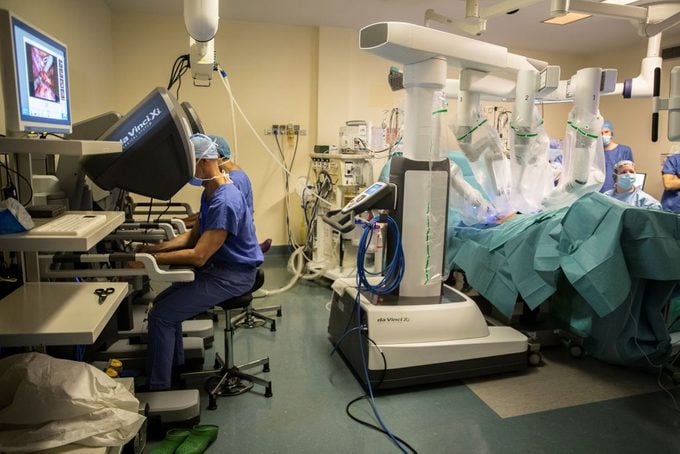
You may have come into contact with a Da Vinci robot, but you likely didn’t realize it. That’s because these articulated robots are used for surgical procedures. While your mind probably jumps to doctors with handheld tools when you think of medical procedures, many surgeons get assistance from such robots. And while the instruments have advanced over the years, robot-assisted surgery isn’t a new thing. In fact, Intuitive, the maker of Da Vinci surgical systems, has been around since the mid-’90s.
With an “arm” and “wrist” that combine the best of human anatomy and the extended range of motion that comes with a robot, the system replicates the movement of a surgeon in real time. The instruments are used for minimally invasive procedures, such as laparoscopic surgery and coronary artery bypass surgery.
Starship delivery robots
Imagine a world in which your packages, groceries and meals are delivered by robots. That’s what Starship Technologies is aiming for with its wheeled, self-driving delivery robots, which deliver packages via an app within a two-mile radius. First launched in 2014 by the co-founders of Skype, these AMR robots currently operate in several cities and on over a dozen college campuses. But the future of the tech is bright, so you just might see regular robot deliveries in your lifetime.
Bot Care
At the 2021 CES consumer electronics show, Samsung announced a new line of robots that can act as caregivers for the sick and elderly. Bot Care, which looks like a character from the movie WALL-E, can set reminders to take your medicine, monitor your heart rate and phone emergency services for help. Don’t expect to bring one home today, though. Bot Care machines are still in the testing phase and are not yet available in stores.
Automower
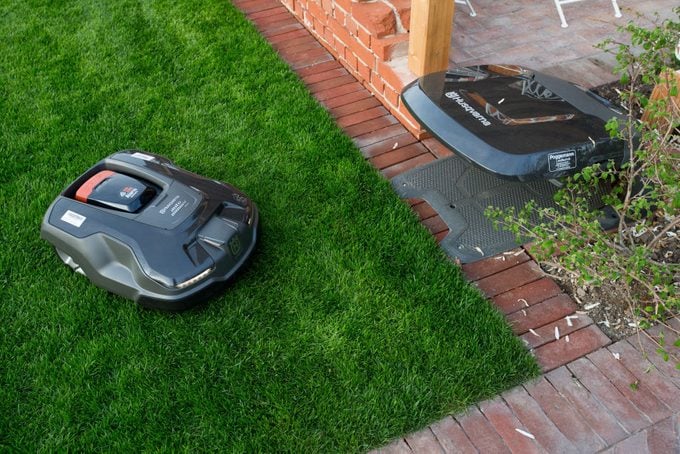
Meet the Roomba of lawnmowers, clipping more than half an acre of grass without requiring you to lift a finger. Solar powered and emissions-free, the Automower uses sensors to move around your lawn and detect obstacles in its path. This AMR was first developed by Husqvarna nearly 20 years ago, and today there is a wide range of models priced anywhere from $1,500 to $3,500.
Leka
In 2017, a French start-up company created Leka, a ball-shaped robot with a digital screen for a face. Designed for children with neurodevelopmental disorders like autism and Down Syndrome, it uses sound, light and colors to help them learn social and visual cues. Children can play customizable, multiplayer games on Leka that teach them skills like color identification, picture matching, hide-and-seek and more.
Robo-fish
Thanks to research published in 2022, robots may one day be able to clean up the world’s polluted oceans. Scientists in China have created self-propelled robotic fish that can collect microplastics in the water. A laser in its tail helps it swim, giving it a speed equivalent to plankton drifting in moving water.
Researchers need to do more testing before this fish can catch any waves, but real robots are already being used for subaquatic tasks like killing off invasive species, detecting pollution and exploring underwater areas that are dangerous or inaccessible to humans.
Ready to learn more about future technology? Get the lowdown on virtual reality, NFTs and Web3.
Sources:
- Robin Murphy, PhD, professor of computer science and engineering at Texas A&M University and director of the Center for Robot-Assisted Search and Rescue
- Chris Atkeson, PhD, professor at Carnegie Mellon University’s Robotics Institute
- SRI International: “Shakey the Robot”
- Reuters: “Exclusive: SoftBank shrinks robotics business, stops Pepper production- sources”
- Boston Dynamics: “Do You Love Me?”
- Scientific American: “The NYPD’s Robot Dog Was a Really Bad Idea: Here’s What Went Wrong”
- CBS Boston: “Robot dog spotted working security with Mass. State Police on Boston Esplanade”
- Stanford News: “Stanford engineers create perching bird-like robot”
- Samsung Research: “[CES 2022] Samsung Research’s New Tech Trio ③ Samsung Bot Handy – Housework robot”
- DARPA: “Big Dog”
- Samsung: “Samsung Introduces Latest Innovations for a Better Normal at CES 2021”
- Nano Letters: “Robust, Healable, Self-Locomotive Integrated Robots Enabled by Noncovalent Assembled Gradient Nanostructure”



